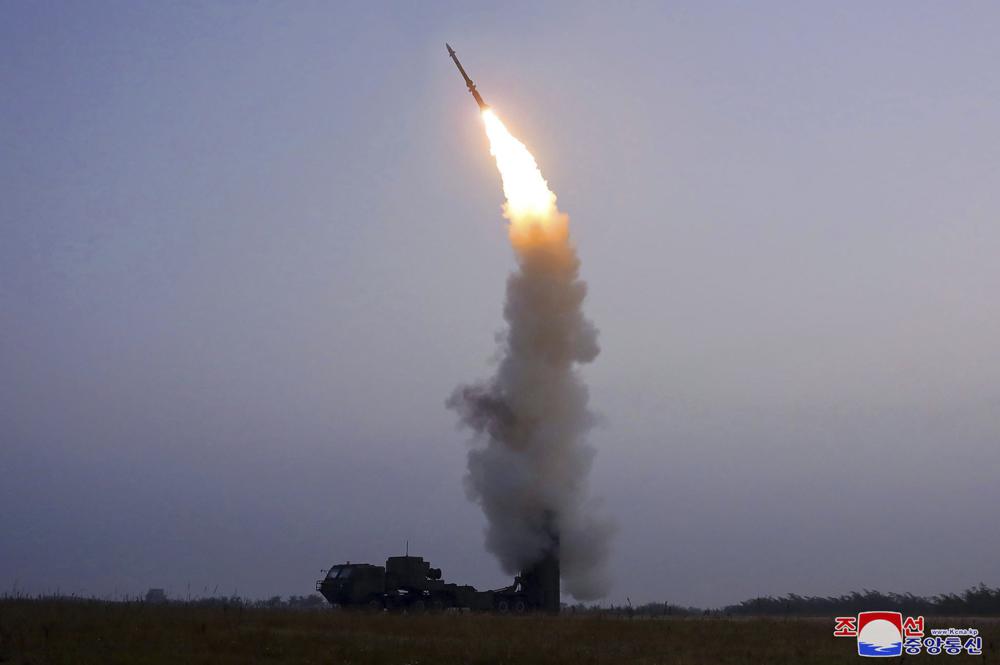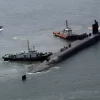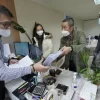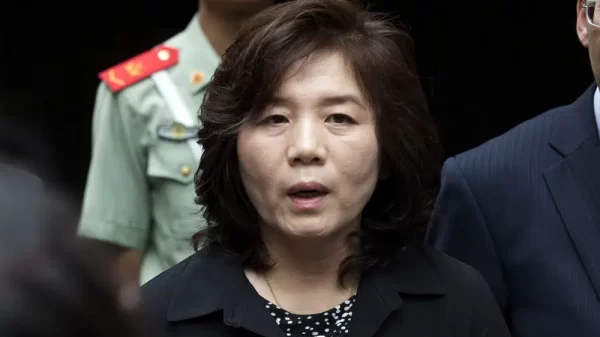This photo provided on Oct. 1, 2021, by the North Korean government shows what North Korea claims to be the test firing of a newly developed anti-aircraft missile in North Korea, Thursday, Sept. 30, 2021. Independent journalists were not given access to cover the event depicted in this image distributed by the North Korean government. The content of this image is as provided and cannot be independently verified. Korean language watermark on image as provided by source reads: “KCNA” which is the abbreviation for Korean Central News Agency. (Korean Central News Agency/Korea News Service via AP)
SEOUL, South Korea (AP) — North Korea said Friday it test-fired a new anti-aircraft missile, the fourth weapons launch in recent weeks that experts say is part of a strategy to win relief from sanctions and other concessions.
South Korea, Japan and the United States typically publicly confirm North Korean ballistic missile launches, which are banned by U.N. resolutions, soon after they occur. But they did not do so for Thursday’s, indicating the weapon tested may have been a different kind. Seoul’s Joint Chiefs of Staff said Friday that South Korean and U.S. intelligence authorities monitored moves by North Korea but didn’t elaborate.
Three weeks ago, North Korea resumed missile tests after a six-month lull. As it has sometimes done before, the North combined the show of force with a more conciliatory gesture, offering earlier this week to reactivate hotlines that North and South Korea use to set up meetings, arrange border crossings and avoid accidental clashes.
Diplomacy aimed at getting the North to abandon its nuclear arsenal in return for economic and political rewards has largely been deadlocked since early 2019. That has left North Korea under crippling U.S.-led economic sanctions, at a time when its fragile economy is suffering massive setbacks due to the coronavirus pandemic. The North’s latest moves appear aimed at pressuring South Korea, which wants to improve strained ties on the peninsula, to persuade the U.S. to relax the sanctions.
On Friday, the Korean Central News Agency said the anti-aircraft missile test was “of very practical significance in studying and developing various prospective anti-aircraft missile system.”
Kim Dong-yub, a professor at the University of North Korean Studies in Seoul, said the launch appears to be the primitive stage of a test to develop a missile designed to shoot down incoming enemy missiles and aircraft. He said the missile resembles the Russian-made S-400 air defense system, which he said has a maximum range of 400 kilometers (250 miles) and is reportedly capable of intercepting stealth jets.
Earlier this week, in his government’s latest mixed signal, North Korea leader Kim Jong Un expressed his willingness to restore the communication hotlines with South Korea in the coming days, but he also shrugged off U.S. offers for dialogue as a “cunning” concealment of its hostility against the North. He also insisted that South Korea abandon its “double-dealing attitude” if it wants to see an improvement in Korean relations. His comments largely echoed demands from his powerful sister, who has taken the lead in the North’s ongoing pressure campaign.
South Korea has said it would prepare for the restoration of the cross-border phone and fax lines, which have been largely dormant for more than a year. But as of Friday afternoon, North Korea remained unresponsive to South Korea’s attempt to exchange messages through the channels, according to Seoul’s Unifications Ministry.
During the Armed Forces Day ceremony on Friday, South Korean President Moon Jae-in vowed to repel any attempt to threaten his people’s lives and would strive to achieve lasting peace. But he didn’t mention North Korea’s recent tests in a possible effort to keep alive the possibility of talks between the Koreas.
U.S. Secretary of State Antony Blinken told reporters Thursday that Washington “certainly supports” inter-Korean dialogue in principle. But he said the U.S. was concerned about North Korea’s recent launches, which he noted were in violation of U.N. Security Council resolutions and created “greater prospects for instability and insecurity.”
U.N. resolutions ban any ballistic activity by North Korea.
Among the weapons North Korea tested in September were a new hypersonic missile, a newly developed cruise missile and a ballistic missile launched from a train. South Korea’s military assessed the hypersonic missile to be at an early stage of development, but experts say the other weapons launched displayed the North’s ability to attack targets in South Korea and Japan, key U.S. allies that host American troops. Earlier this week, the U.S. Indo-Pacific Command said its commitment to the defense of South Korea and Japan “remains ironclad.”
North Korea has not tested a long-range missile capable of reaching the U.S. mainland for about four years — what experts see as an indication it is carefully calibrating its provocations to keep alive its chances for diplomacy.
Associated Press writer Matthew Lee in Washington contributed to this report.
Copyright 2021 Associated Press. All rights reserved.
Source: https://apnews.com/article/seoul-south-korea-north-korea-aaa57ba3db6551da5bafca8b6ee1a480










































